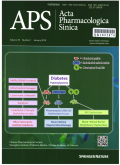- 钛学术文献服务平台 \
- 学术期刊 \
- 医药卫生期刊 \
- 药学期刊 \
- 中国药理学报(英文版)期刊 \
null
Progress and prospects in stem cell therapy and drug discovery
基本信息来源于合作网站,原文需代理用户跳转至来源网站获取
摘要:
During the past few years,we witnessed explosive progress in the field of stem cell research,leading to an increasing hope for more effective cell replacement therapies to treat various diseases.The self-renewal capability of stem cells,combined with their ability to differentiate into different cell types under programmed conditions,enables improved models for drug discovery and mechanism-based studies of diseases,hence laying the foundation for their therapeutic applications[1].In fact,induced pluripotent stem cell (iPSC)-based transplantation therapy has already been performed in rodent models[2].
The examples of major progress are seen in the multiple fronts.Active small molecules have been identified to promote stem cell self-renewal,proliferation,differentiation and somatic cell reprogramming[3].The effective applications of iPSC technology open a new path for cell replacement therapies and drug screening.Furthermore,patient-specific iPSCs and subsequently differentiated cells manifesting disease phenotypes allow reconstitution of human disease pathology in cell culture,thus offer precious opportunities to investigate human proteins in the native cellular context.

推荐文章
期刊_丙丁烷TDLAS测量系统的吸收峰自动检测
带间级联激光器
调谐半导体激光吸收光谱
雾剂检漏 中红外吸收峰 洛伦兹光谱线型
不同盐度、温度及光照对漂浮浒苔生理生态的影响
浒苔
盐度
温度
光照
生理生态
期刊_联合空间信息的改进低秩稀疏矩阵分解的高光谱异常目标检测
高光谱图像
异常目标检测 低秩稀疏矩阵分解 稀疏矩阵 残差矩阵
内容分析
关键词云
关键词热度
相关文献总数
(/次)
(/年)
文献信息
| 篇名 | Progress and prospects in stem cell therapy and drug discovery | ||
| 来源期刊 | 中国药理学报(英文版) | 学科 | |
| 关键词 | |||
| 年,卷(期) | 2013,(6) | 所属期刊栏目 | |
| 研究方向 | 页码范围 | 717-718 | |
| 页数 | 2页 | 分类号 | |
| 字数 | 语种 | 英文 | |
| DOI | 10.1038/aps.2013.72 | ||
五维指标
引文网络
引文网络
二级参考文献 (677)
共引文献 (61)
参考文献 (13)
节点文献
引证文献 (0)
同被引文献 (0)
二级引证文献 (0)
1900(2)
- 参考文献(0)
- 二级参考文献(2)
1958(1)
- 参考文献(0)
- 二级参考文献(1)
1963(1)
- 参考文献(0)
- 二级参考文献(1)
1980(1)
- 参考文献(0)
- 二级参考文献(1)
1981(4)
- 参考文献(0)
- 二级参考文献(4)
1982(1)
- 参考文献(0)
- 二级参考文献(1)
1983(1)
- 参考文献(0)
- 二级参考文献(1)
1984(1)
- 参考文献(0)
- 二级参考文献(1)
1986(1)
- 参考文献(0)
- 二级参考文献(1)
1987(2)
- 参考文献(0)
- 二级参考文献(2)
1988(1)
- 参考文献(0)
- 二级参考文献(1)
1989(1)
- 参考文献(0)
- 二级参考文献(1)
1992(1)
- 参考文献(0)
- 二级参考文献(1)
1993(1)
- 参考文献(0)
- 二级参考文献(1)
1994(1)
- 参考文献(0)
- 二级参考文献(1)
1995(1)
- 参考文献(0)
- 二级参考文献(1)
1996(2)
- 参考文献(0)
- 二级参考文献(2)
1997(7)
- 参考文献(0)
- 二级参考文献(7)
1998(6)
- 参考文献(0)
- 二级参考文献(6)
1999(4)
- 参考文献(0)
- 二级参考文献(4)
2000(8)
- 参考文献(0)
- 二级参考文献(8)
2001(4)
- 参考文献(0)
- 二级参考文献(4)
2002(6)
- 参考文献(0)
- 二级参考文献(6)
2003(7)
- 参考文献(0)
- 二级参考文献(7)
2004(12)
- 参考文献(0)
- 二级参考文献(12)
2005(12)
- 参考文献(0)
- 二级参考文献(12)
2006(15)
- 参考文献(0)
- 二级参考文献(15)
2007(27)
- 参考文献(0)
- 二级参考文献(27)
2008(73)
- 参考文献(1)
- 二级参考文献(72)
2009(82)
- 参考文献(0)
- 二级参考文献(82)
2010(86)
- 参考文献(0)
- 二级参考文献(86)
2011(120)
- 参考文献(0)
- 二级参考文献(120)
2012(98)
- 参考文献(1)
- 二级参考文献(97)
2013(38)
- 参考文献(11)
- 二级参考文献(27)
2014(14)
- 参考文献(0)
- 二级参考文献(14)
2015(6)
- 参考文献(0)
- 二级参考文献(6)
2016(11)
- 参考文献(0)
- 二级参考文献(11)
2017(16)
- 参考文献(0)
- 二级参考文献(16)
2018(4)
- 参考文献(0)
- 二级参考文献(4)
2019(9)
- 参考文献(0)
- 二级参考文献(9)
2020(2)
- 参考文献(0)
- 二级参考文献(2)
2013(38)
- 参考文献(11)
- 二级参考文献(27)
- 引证文献(0)
- 二级引证文献(0)
引文网络交叉学科
相关学者/机构
期刊影响力
中国药理学报(英文版)
主办单位:
中国药理学会和中科院上海药物研究所
出版周期:
月刊
ISSN:
1671-4083
CN:
31-1347/R
开本:
大16开
出版地:
上海市太原路294号
邮发代号:
4-295
创刊时间:
1980
语种:
eng
出版文献量(篇)
4416
总下载数(次)
2
总被引数(次)
42236
期刊文献
相关文献
推荐文献
- 期刊分类
- 期刊(年)
- 期刊(期)
- 期刊推荐
中国药理学报(英文版)2022
中国药理学报(英文版)2021
中国药理学报(英文版)2020
中国药理学报(英文版)2019
中国药理学报(英文版)2018
中国药理学报(英文版)2017
中国药理学报(英文版)2016
中国药理学报(英文版)2015
中国药理学报(英文版)2014
中国药理学报(英文版)2013
中国药理学报(英文版)2012
中国药理学报(英文版)2011
中国药理学报(英文版)2010
中国药理学报(英文版)2009
中国药理学报(英文版)2008
中国药理学报(英文版)2007
中国药理学报(英文版)2006
中国药理学报(英文版)2005
中国药理学报(英文版)2004
中国药理学报(英文版)2003
中国药理学报(英文版)2002
中国药理学报(英文版)2001
中国药理学报(英文版)2000
中国药理学报(英文版)1999
中国药理学报(英文版)1998
中国药理学报(英文版)2013年第9期
中国药理学报(英文版)2013年第8期
中国药理学报(英文版)2013年第7期
中国药理学报(英文版)2013年第6期
中国药理学报(英文版)2013年第5期
中国药理学报(英文版)2013年第4期
中国药理学报(英文版)2013年第3期
中国药理学报(英文版)2013年第2期
中国药理学报(英文版)2013年第12期
中国药理学报(英文版)2013年第11期
中国药理学报(英文版)2013年第10期
中国药理学报(英文版)2013年第1期

 免费查重
免费查重










